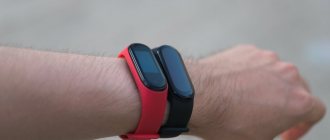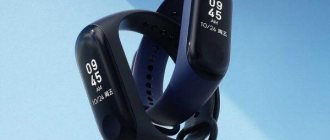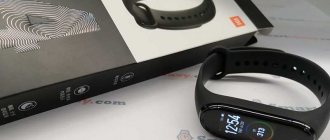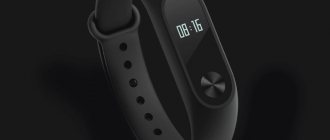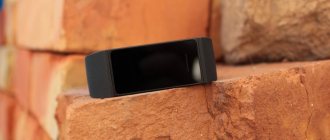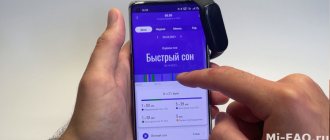Equipment
Mi Band 2 came to me in exactly the same box as the latest 1S tracker. It's still a small, flattened package made from recycled yellow cardboard. The company's smartphones began to receive white boxes with color printing, and trackers are still supplied in boxes that have long been familiar to everyone. Maybe Xiaomi has them prepared for a hundred years in advance?
Inside we find the following: the tracker itself (core), which is fixed separately, a bracelet and a charging cable are laid under it. Everything is the same as always. There is a small manual with a brief guide to initial setup and a QR code so you can quickly download the proprietary application. We don’t need all this, we already know that Mi Fit can be installed from the Google Play Store. However, first let's talk about the appearance of the device.
Ease of use
At the presentation of Mi Band 2, the Chinese company Xiaomi said that the bracelet will have a new recycled strap made of special silicone that does not cause allergies. Xiaomi also claims that the strap now prevents the device from being accidentally lost.
In practice, this is all true: the bracelet really does not allow the Mi Band 2 to fall out while being worn; the capsule is taken out through the back of the strap, which is usually pressed against the hand. The strap itself has a thinner clip and when fastening you can hear a characteristic click as confirmation.
The bracelet sits confidently on your hand, and when you bend your hand, Mi Band 2 is not squeezed out of the strap, as was the case with the first Mi Band. Xiaomi did their best, now users will not have problems with losing their fitness tracker.
Design
To my taste, the second generation of the fitness tracker has lost the very recognizable, pleasant, and most importantly, minimalistic design that is characteristic of Xiaomi products.
For those interested in technology, who spend hours on forums, reading the news feed (ours first of all, how could it be otherwise?!), the device quickly became recognizable. Now try to abstract yourself from this, discard all your liking for the brand and look at the tracker again, as if you were seeing it for the first time.
Obviously, this is another noname tracker with a heart rate monitor. There is no smell of the famous Mi design here.
To confirm my words, below is a collage of a bunch of photos of a variety of trackers that I found in one popular Chinese store. The task is to find our hero in the image in 5 seconds.
I think it’s now clear that the new product is no different from dozens of other competitors.
The first “miband” and 1S also had a noble coating of matte aluminum alloy, a thin mirror bezel around the perimeter, and beautiful LEDs that flickered neatly in time with a particular event. The gadget was created at the intersection of technology and art, and besides, it was inexpensive.
Now there is technology, an affordable price, but there is no smell of art here. Dark glass, some kind of button, I don’t understand why it was there. And it’s not a button at all, but just a touch pad. It only recognizes single touches. She doesn’t understand gestures, swipes, double taps and other acrobatic tricks.
By touching, you can switch the displayed information, cancel the alarm, turn off the vibration of the bracelet when a call arrives (you cannot accept or reject a call). That's probably all.
I also struggled with the tracker while taking test photos.
On the left is Mi Band 1, on the right is Mi Band 2
The thing is that the glass here is a real dust collector.
Motes of dust, fine dirt and other slag constantly stick to it. A soft cloth does not help, because due to static, the dust still sticks to the surface.
In my opinion, the new pedometer looks boring and it will only come out on the wave of popularity of the first generation, which has only been heard of in a remote, remote taiga village. Even the protective glass slightly rounded on the sides does not save the situation.
By the way, it has an oleophobic coating, but it gets scratched very quickly. A fine mesh of them, which is usually visible in bright sunshine, appeared already on the second day of use.
Scratches appear literally on the second day of use
It’s scary to imagine what will happen to the device after a couple of months of everyday use. And putting a protective film on the tracker is still a perversion.
Nevertheless, the films still appeared on sale. One and a half dollars apiece.
Another unpleasant moment. There is a tiny gap between the glass and the plastic button. Dust immediately gets clogged there and it all looks as if you had just arrived from potatoes and didn’t take off the miband when you were digging it.
Testing in aggressive conditions
Despite the IP67 protection against water and dust declared by the manufacturer, users quite often complained about the Mi Band 1 and 1s due to leaks. The test unit perfectly survived hot and cold showers and even attempts to drown it under a direct stream of water for an hour. True, it was revealed that the first touch of a stream of hot water activates the button. If the flow is not interrupted due to movements or turning off the water, repeated alarms are not observed.
The button also works on a bracelet frozen to −18 °C. Moreover, both after removal from the freezer and directly in it. Reacts to cold and wet fingers.
Ergonomics and reliability
It's no secret that losing the 1st generation Mi Band was easy. I’ve had it jump out, getting caught on a backpack strap or shirt sleeve, about four times. This was due to the ill-conceived design of the strap and the tracker itself.
The core could be inserted into the bracelet both from the inside and from the outside. Over time, the elastic band became loose (a year later everything tore and peeled off) and the capsule could “shoot” from the hand almost on its own.
Strap from the first generation Mi Band
Strap from Mi Band 2
The new device has been vaccinated against all these childhood diseases.
The attachment location of the core itself and the small rim have been changed, due to which the capsule itself is now attached much more securely than before.
In addition, the new product is inserted into the mount only through the back side. Of course, this can be done from the outside, but much more force will be required. From here there is hope that the capsule will no longer cling and jump out of the strap.
The clasp, in my opinion, has not changed much. From a reliability point of view, of course. Externally, it is a completely different element. It won't scratch the same way on the table when you put your wrist on it.
And besides, the metal button will no longer scratch the surface of the laptop next to the touchpad.
The fixing loop has become thicker, hence there is reason to believe that it will not break as quickly as it did for me (after about four months of use).
And the bracelet itself has become thicker (2.7 versus 3 mm, although the thickness varies along its entire length) and wider (13 versus 14.3 mm).
In general, in terms of reliability, all the shortcomings were eliminated, the work was carried out in the right direction. Hence the lack of backward compatibility. Accessories from the first generation do not fit the second.
The size of the tracker has increased and this, I think, is good. The first Mi Band looked good on my wrist. However, on wider wrists the small silver pebble looked somewhat comical. The 2nd generation is larger, hence its greater versatility.
I didn’t notice any significant changes in the quality of the materials of the strap itself. Still the same pleasant, smooth to the touch, but matte bracelet. Alternate colors have been slightly changed. All of them, to my taste, look stylish and fresher.
And even earlier, Mi Band could be worn on either side of the hand. Now the touch pad must be strictly under the screen, otherwise you will look at the numbers upside down. Their orientation cannot be changed. I got caught doing this three or four times, then I started tracking how I put the device on my hand.
Fixation Features
The strap is made of durable rubberized material that is pleasant to the touch. The tracker is more massive than its predecessor, and so is the fixation for it. The thickness has increased to 3 mm and the width to 14.3 mm.
All the shortcomings of the first model have been taken into account, which is pleasantly pleasing. Now the capsule is fixed much more securely, there is no risk that it will fall out. This eliminates the special ring on the rim of the strap. For the same reason, it is much easier to insert the capsule from below. The strap lock button has also been improved. In other words, the developers have worked hard to make wearing more comfortable. Initially, the set comes with a black bracelet. If desired, you can buy straps in other colors. All colors go well with the tracker capsule.
Display
The first generation was sorely lacking only one function - time display. We don't often watch our activity. To do this, you can always take out your smartphone and get the latest data. But I would like to always be aware of what time it is.
Even when Mi Band 2 was not announced, I became terribly interested in how Xiaomi were going to get out of the situation. After all, you need to fit a screen into the body of your brainchild without losing its attractive appearance.
Time
Steps
Distance
The second generation is out. I am disappointed. Xiaomi failed to cope with the task. No, there is now a display, but there is no design or recognizable face. Just look again at the collage with competitors.
The second pedometer from Xiaomi is now just one of many, it has lost its unique design.
A 0.42-inch OLED display is installed here. It sounds cool, but it's actually not that great.
The screen here is black and white. Numbers and symbols are pale green. And at a certain angle in the sun you can see the rectangular window of this display, which does not fit into the concept of the rounded design of the tracker itself.
The screen backlight cannot be on all the time. It turns on only when you touch the touch surface under the screen or when you raise your wrist to see the time. By the way, the gesture works great - the display almost always lights up when you raise your hand. Of course, there are also false alarms, for example, when you are driving.
The brightness of the screen cannot be adjusted. At night it does not dazzle; in the sun it is rather weakly visible. I wish there was more.
In general, thanks to this display, Mi Band 2 reminds me a lot of Huawei TalkBand B1, which was released more than two years ago. The front side was also made of dark glass, and underneath it was a tiny OLED panel. True, the backlight there was much brighter.
Full technical specifications of Mi Band 2
- OLED screen with a diagonal of 0.42 inches (resolution is not specified, but it is not high)
- battery (lithium polymer) 70 mAh
- main materials: plastic, aluminum
- protection against moisture and dust IP67
- Bluetooth 4.0 BLE support
- Sensors: accelerometer, heart rate monitor with green LED
- weight 7 grams
- Dimensions: 15.7 x 40.3 x 10.5 mm (without strap)
- total strap length: 235 mm, adjustable length 155-210 mm
- operating temperatures (relevant for Russia and the Sahara): -20 - +70 C°
- a drop from a height of 1.2 meters onto a marble floor should not damage the gadget (according to the manufacturer)
Compatibility is an extremely important point. Our hero will not make friends with a Bluetooth version below 4.0. There is only one way out - update your smartphone.
The operating system also has its own requirements. The proprietary application will run only on Android, starting from 4.4, and on iOS no younger than 7.0. The iOS version is translated into Russian a little worse. However, the application for Apple devices has always lagged behind its Android competitor in terms of functionality.
Like its predecessor, the updated model can conduct its owner’s activities independently from a smartphone.
You don't have to be connected all the time. It is enough to synchronize even once every two weeks, but not less often, because the amount of built-in memory on the tracker is still limited.
Connection and functionality
Somehow I didn’t realize it before - I didn’t connect two Mi Bands to one application and account at the same time. It turns out that you first need to unplug your old tracker and then connect the new one. Only then the icon for connecting a new device will become active.
When connecting to the smartphone for the first time, the bracelet decided to update the firmware. And he did this much longer than his predecessor. It took me about 5 minutes to download and install the update. It feels like the technology has become more serious.
During the first connection, the time is set (automatically), which is pulled up from the smartphone. Synchronization occurs only in this way. If suddenly something goes wrong, we untie the gadget and pair it again.
If the connection is lost, the connection itself is not restored. I left the house without a bracelet, taking only my smartphone with me. Later I returned home, put on the tracker, and only a few hours later I was surprised to find that I was not receiving any notifications. I had to “connect” the devices manually. I think this point will be corrected in the next updates.
We measure the pulse
Measurement error
Remaining charge
The functionality is basically the same:
- heart rate measurement (only at rest)
- step counting
- sleep phase tracking
- alarm clock via vibration (no smart wake-up)
- notifications (ringing after three seconds, notification of inactivity)
- unlocking a smartphone (not on iOS)
Of course, the data can be synced with Google Fit. If you are Chinese, then WeChat or Weibo will do.
A little more about application notifications. There can be five of them in total. It is not possible to attach anything else to the pedometer. However, notifications about the receipt of new SMS pass on their own.
Thanks to the clearly marked touch key, you can now measure your pulse not only from the application, but also directly from your hand. I selected the item with a heart, waited a second or two, and the measurement began. In the video below I show how it all works.
No special menu items appeared in the application, such as backlight time settings or something similar. Of the goodies specific to the second generation, you can only configure what is displayed on the display: time (cannot be turned off), steps, running, temperature, pulse and charge percentage. It is important to clarify here. I made no mistake with the “Temperature” item. In Mi Fit, this is what they call burned calories, the amount of which can be monitored directly from the tracker. I think the translation bug will be fixed soon.
The vibration has become less noticeable compared to the first one.
If the first generation vibrated on the hand, then almost the entire hand rattled at once. In the new product, first of all, it is weak. Secondly, it’s some kind of synthetic or something. Not ice, in general.
Incoming call icon
Mi Band 2 measures heart rate this way
Alarm clock vibrates
An SMS arrived on your smartphone
Xiaomi claims that they have added updated hardware to the new generation, and also improved activity counting algorithms. As for me, everything was very good before. The pulse was also calculated quite correctly.
Nothing can be customized. It would be great if in the application you could select some status or avatar and put it on the tracker screen. In any case, this cannot be done for now.
Advantages and disadvantages of the model
As for the advantages of the device, the following can be noted:
- Affordable and affordable price tag;
- High quality workmanship;
- Ease of use;
- Safe to wear;
- Advanced functionality;
- Long life without recharging.
There are also some disadvantages, including:
- Not very accurate heart rate measurements in active mode;
- Some problems with localization;
- Difficulty perceiving information in bright lighting.
Battery life
The manufacturer claims 20 days of battery life. The predecessor worked on a single charge (again, according to the official statement) for 30 days. However, in fact it was two, or even three months. Everything depended, of course, on the frequency of notifications and vibration.
In our case, there are no reliable results yet. I've only been wearing the device for the second day and now the tracker has lost 12% of its charge. This takes into account the initial setup, installation of new firmware and all my tests. It is clear that even one full cycle has not yet passed, so it is too early to draw conclusions.
It seems to me that 20 days of autonomy is an honest and real indicator of the gadget’s performance.
Prices and offers
Buying Xiaomi Mi Band 2 is not easy now. There are three types of prices for a new product. Let's look at each of them separately.
The official price is 149 Chinese yuan or a little over 22 dollars, or 1,500 rubles. Definitely a worthy price for such a well-assembled device. Despite the appearance, we are still dealing with not just a basement Chinese production or some no-name craft, but a high-quality gadget, the functionality and performance of which will only increase over time. In this regard, I have no doubts about Xiaomi. The only negative is the inability to purchase a bracelet at the manufacturer's price. Do you have a Chinese map? Address in China? No? Then read on.
The best option is to buy a pedometer in some online store. For example, on Gearbest. Why there? Because, firstly, the bracelet came to me from there. So, it’s been tested and tested on itself, so to speak. Secondly, the price of Xiaomi Mi Band 2 on this site looks quite reasonable - $34.04.
The third price is not adequate. Now there are certain supply interruptions, which are entirely the responsibility of the manufacturer. Believe me, not one online seller benefits from delaying sales, shipping, and, as a result, clearing out warehouse space and not receiving the required amount of cash flow. Unfortunately, this is where local resellers come in and are happy to sell the tracker for 4,500 - 5,000 rubles (current price in Moscow at the time of publication). Of course, the gadget is not worth this money. It’s not worth even three thousand rubles. The cost is lower - that's another conversation.
Autonomy
The stated operating time is 20 days, and the built-in battery has a capacity of 70 mAh. Full charging from a computer's USB port takes about an hour and a half; the charging progress is displayed on the bracelet's screen, and after it's finished, a notification will be sent to your smartphone.
I tested the bracelet for exactly a week - during this time it was discharged by 43% percent, while the Mi Band 2 was connected to different smartphones, the heart rate monitor functions were actively tested, the time was checked relatively often, the number of steps taken was checked, and so on. The operating time corresponds to the stated one.
Depending on the frequency of use of the heart rate monitor and the screen, the operating time will vary slightly, both up and down. Even taking into account the reduction in the stated operating time from 30 to 20 days, compared to previous versions, the bracelet still remained very durable and this operating time would be the envy of most competitors.
4.5
ITC.UA rating
Pros: Universal and improved design, new screen, better accuracy of step counting, operating time, presence of a heart rate monitor
Cons: Inaccuracies in application localization, differences in functionality between different versions of the application
Conclusion: Xiaomi Mi Band 2 is a successful update to one of the most popular fitness bracelets. The company added a screen that many users wanted so much, fixed the jambs of previous versions - silicone bracelets have become more durable, and the capsule will not fall out, although final conclusions can only be drawn after long-term use. At the same time, all the advantages of previous versions have been preserved, namely, standard operating time and low cost. Yes, at the start of sales for the Mi Band 2 they are asking much more than the $23 announced by Xiaomi, but shortages and demand exceeding supply are a common occurrence for all “hot new products,” so those who want to save money can be advised to wait a couple of months for the price to drop to $30-35. Users of previous versions should know that the new bracelet will only give you a screen and a slightly improved design. On the one hand, these are little things, on the other hand, they make the gadget more interesting. Xiaomi has done “cheap and cheerful” again and this trick should work once again.

